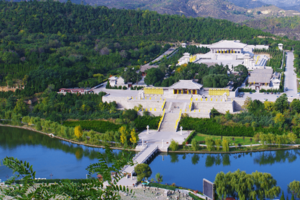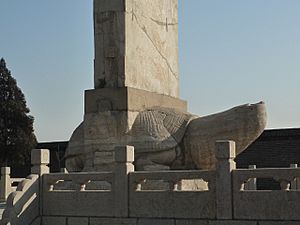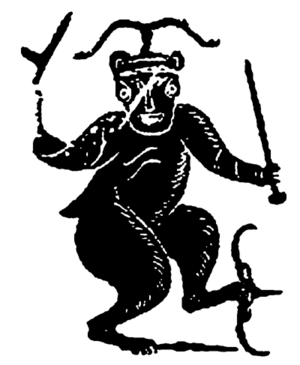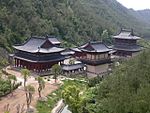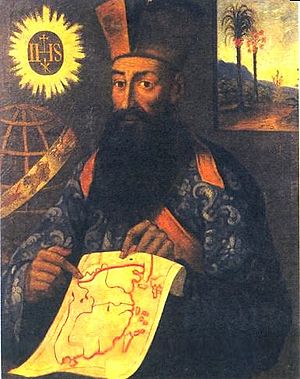Yellow Emperor facts for kids
Quick facts for kids Yellow Emperor黃帝 |
|||||||||||||||||||||||||
|---|---|---|---|---|---|---|---|---|---|---|---|---|---|---|---|---|---|---|---|---|---|---|---|---|---|
| One of the Three Sovereigns and Five Emperors | |||||||||||||||||||||||||
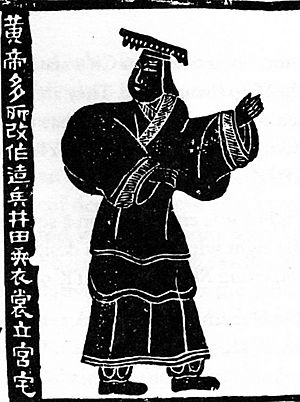
The Yellow Emperor as depicted in a tomb from the mid second century AD. The inscription reads: "The Yellow Emperor created and changed a great many things; he invented weapons and the well-field system; he devised upper and lower garments, and established palaces and houses."
|
|||||||||||||||||||||||||
| Reign | 2698–2598 BC (mythical) | ||||||||||||||||||||||||
| Predecessor | Fuxi | ||||||||||||||||||||||||
| Successor | Shaohao (disputed)/ Zhuanxu | ||||||||||||||||||||||||
| Born | 2711 BC | ||||||||||||||||||||||||
| Died | 2598 BC (aged 113) | ||||||||||||||||||||||||
| Spouse |
|
||||||||||||||||||||||||
| Issue |
|
||||||||||||||||||||||||
|
|||||||||||||||||||||||||
| Father | Shaodian | ||||||||||||||||||||||||
| Mother | Fubao | ||||||||||||||||||||||||
| Chinese name | |||||||||||||||||||||||||
| Traditional Chinese | 黃帝 | ||||||||||||||||||||||||
| Simplified Chinese | 黄帝 | ||||||||||||||||||||||||
| Literal meaning |
|
||||||||||||||||||||||||
|
|||||||||||||||||||||||||
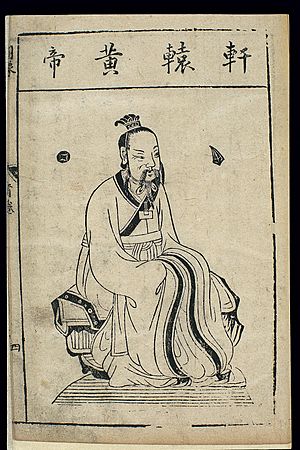
The Yellow Emperor, also known as Huangdi, is a very important figure in Chinese mythology. He is considered one of the legendary Chinese rulers and a culture hero. People often include him among the Three Sovereigns and Five Emperors, who were ancient, mythical leaders. Many believe he ruled around 2698–2598 BC.
The Yellow Emperor became very famous during the Warring States period and early Han dynasty. He was seen as the person who started the idea of a strong, central government in China. He was also thought to be a cosmic ruler and a supporter of special, secret knowledge. Many important books, like the Huangdi Neijing (a medical book) and the Huangdi Sijing (political writings), were said to be written by him.
Even today, the Yellow Emperor is a powerful symbol in Chinese nationalism. People traditionally credit him with many inventions and new ideas. These include the Chinese calendar and an early form of cuju (like football). The Yellow Emperor is now seen as the founder of Chinese culture.
Contents
What are the Yellow Emperor's Names?
Understanding "Huangdi": Yellow Emperor or Yellow Thearch
Before 221 BC, the word di (帝) did not mean "emperor" for earthly rulers. Instead, it referred to the highest god of the Shang Dynasty. In the Warring States period, di could also mean gods linked to the five Sacred Mountains of China and different colors.
Huangdi (黃帝), the "yellow di", was one of these gods. To show the religious meaning of di before emperors, historians often translate his name as "Yellow Thearch." This means a godly ruler.
The Yellow Emperor was connected to the idea of the Five Phases. In this system, the color yellow stands for the earth element, the Yellow Dragon, and the center. An old text, the Lüshi Chunqiu, said that the Yellow Emperor's rule was guided by earth. The Chinese character huang (黃) meaning "yellow" was often used instead of a similar-sounding word huang (皇), which means "august" or "radiant." This gave the Yellow Emperor qualities similar to Shangdi, the supreme god of the Shang dynasty.
Xuanyuan and Youxiong: Other Important Names
The Records of the Grand Historian, written by Sima Qian, calls the Yellow Emperor "Xuan Yuan" (simplified Chinese: 轩辕; traditional Chinese: 軒轅; pinyin: Xuān Yuán). Some scholars believe Xuanyuan was the name of a hill where Huangdi lived. He later took this as his own name.
The Classic of Mountains and Seas mentions a Xuanyuan nation. Its people had human faces, snake bodies, and tails. Some think this might show what the Yellow Emperor himself looked like. Xuanyuan is also the Chinese name for the star Regulus. This star is linked to Huangdi in old astronomy. He is also connected to the constellations Leo and Lynx. The Lynx constellation is said to be the body of the Yellow Dragon (黃龍 Huánglóng), which is Huangdi's animal form.
Huangdi was also called "Youxiong" (Chinese: 有熊; pinyin: Yǒuxióng). This name might be a place name or a clan name. One idea is that it came from his family's land. Another idea is that Huangdi was the leader of the Youxiong clan. This clan lived near what is now Xinzheng in Henan. Some historians connect "Youxiong" to "possessor of bears." This links Huangdi to bear legends found in other parts of Asia.
Other Titles for the Yellow Emperor
Sima Qian's Records of the Grand Historian says the Yellow Emperor's family name was Gongsun (公孫).
In texts from the Han dynasty, the Yellow Emperor is sometimes called the "Yellow God" (黃神 Huángshén). Some stories say he was a form of the "Yellow God of the Northern Dipper" (黄神北斗 Huángshén Běidǒu). This is another name for the universal god. Old texts say the Yellow Emperor "comes from the spirit of the Yellow God."
As a cosmic god, the Yellow Emperor is known as the "Great Emperor of the Central Peak" (中岳大帝 Zhōngyuè Dàdì). In the Shizi, he is called the "Yellow Emperor with Four Faces" (黃帝四面 Huángdì Sìmiàn). Ancient stories also describe him as a god of light and thunder. He is sometimes seen as the same as the "Thunder God" (雷神 Léishén). However, in later myths, the Thunder God is shown as the Yellow Emperor's main student.
Was the Yellow Emperor a Real Person?
For a long time, Chinese historians like Sima Qian thought the Yellow Emperor was a real historical figure. They saw him as more real than other legendary figures like Fu Xi or Shennong. Sima Qian's Records of the Grand Historian starts with the Yellow Emperor's story.
However, in the 1920s, historians like Gu Jiegang began to question this. They were part of the Doubting Antiquity School. They argued that these ancient wise figures were originally gods. Later, thinkers from the Warring States period described them as human rulers. Yang Kuan, another historian, pointed out that the Yellow Emperor was only described as China's first ruler during the Warring States period. He suggested that Huangdi was a later version of Shangdi, the supreme god of the Shang Dynasty.
Most scholars today agree that the Yellow Emperor started as a god. He was later shown as a historical person. Historians like K.C. Chang see Huangdi as an "ancient religious figure." He was "humanized" during the late Warring States and Han periods. Mark Edward Lewis talks about the Yellow Emperor's "earlier nature as a god." Roel Sterckx calls Huangdi a "legendary cultural hero."
How the Yellow Emperor Myth Began

The exact start of the Yellow Emperor's myth is not clear. Historians have different ideas about it. Some scholars believe the Yellow Emperor came from Shangdi, the highest god of the Shang Dynasty.
Another idea suggests that "Huang" in "Huangdi" might have originally meant "rainmaking shaman." This connects Huangdi to ancient rituals for making rain. In these stories, Huangdi represented the power of rain and clouds. His rival, Chiyou, stood for fire and drought.
Other historians believe that the Yellow Emperor was originally a "lord of the underworld." This would make him the mythical opposite of the Shang sky god, Shangdi. Over time, this underworld lord became a historical ruler. His descendants were thought to have founded the Xia dynasty.
Some historians also think Huangdi was created as an ancestor figure. This was a way to claim that all ruling families in the Zhou dynasty area shared a common family history.
The Yellow Emperor's Importance Through History
First Mentions of Huangdi
Stories about the Yellow Emperor first appeared in Chinese texts during the Warring States period. The oldest known mention of Huangdi is on a bronze object. It was made in the early 4th century BC by the royal family of the state of Qi. This powerful eastern state was where many ideas about the Yellow Emperor began.
Growing Popularity in the Warring States Period
The worship of Huangdi became very popular during the Warring States period (5th century–221 BC). This was a time of many wars between different states. The period ended when the state of Qin united China. Besides being an ancestor, Huangdi became linked to "centralized government." He was seen as a perfect example of an emperor.
The Qin State and the Shiji Version
Sima Qian wrote in his Records of the Grand Historian that the state of Qin began worshiping the Yellow Emperor in the 5th century BC. By the time Qin Shi Huang became the First Emperor of a united China in 221 BC, Huangdi was the most important god they worshiped.
Sima Qian's Shiji (finished around 94 BC) was the first to tell a full story of the Yellow Emperor's life. This story was very important in shaping how Chinese people saw their own history. The Shiji starts its history with Huangdi. It describes him as a wise ruler from ancient times. It says his father was Shaodian and his mother was Fubao. The Yellow Emperor had four wives and 25 sons. His first wife, Leizu, had two sons. When the Yellow Emperor died, his grandson Zhuanxu took over.
The Shiji also said that all past rulers were descendants of Huangdi. This made it seem like Chinese history was the story of one big family.
Huangdi in Imperial China
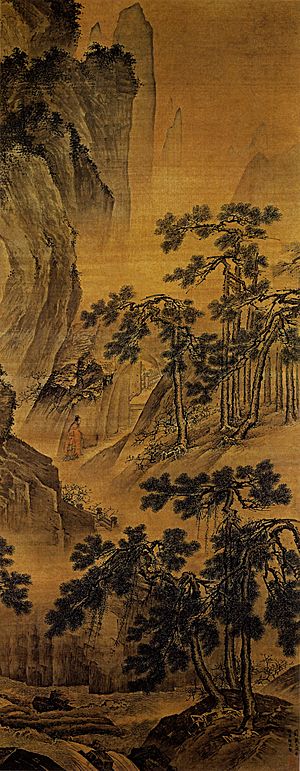
The Yellow Emperor was credited with many cultural achievements and secret teachings. While Taoism is often linked to Laozi, Chinese Taoists say the Yellow Emperor created many of their ideas. The Yellow Emperor's Inner Canon, a key text for traditional Chinese medicine, is named after him. He was also said to have written the Four Books of the Yellow Emperor.
"Xuanyuan" is also the Chinese name for the star Regulus. This star and other constellations are linked to the Yellow Dragon, which is Huangdi's animal form. In the Forbidden City in Beijing, there is a mirror called the "Xuanyuan Mirror."
Huangdi in the 20th Century
[[multiple image| align = right | direction = vertical | header = | header_align = left/right/center | footer = Top image: A five-yuan banknote with the Yellow Emperor, from 1912.
Bottom image: A 100-yuan banknote with the Yellow Emperor, from 1938. | footer_align = left | image1 = Chinese Republic Banknotes 1912.jpeg| width1 = 350 | caption1 = | image2 = 1938 banknote by the Federal Reserve Bank of China.jpg| width2 = 350| caption2 = ]]
The Yellow Emperor became a strong national symbol in the early 1900s. This was during the end of the Qing dynasty and the start of the Republican period. In 1903, some groups started using the Yellow Emperor's birth year as the first year of the Chinese calendar. This was to show the long history of the Han Chinese people. Revolutionaries used the Yellow Emperor to unite people against the Qing dynasty, which they saw as foreign rule. They said the "Han race" was one big family from the Yellow Emperor. The first issue of the Minbao magazine even called Huangdi "the first great nationalist of the world."
Many historians think this sudden popularity was a response to a theory that Chinese civilization came from Babylonia. Chinese scholars used the Yellow Emperor to show that Chinese civilization was ancient and important on its own.
After the 1911 revolution, the Yellow Emperor was still honored. In 1912, new banknotes even showed his picture. But his role changed. He became the ancestor of all of China's many ethnic groups, not just the Han. This was part of the idea of "Five Races Under One Union." Huangdi was seen as the common ancestor of the Han, Manchu, Mongols, Tibetans, and Hui people. These groups together formed the Zhonghua minzu, or the Chinese nation.
Modern Importance of Huangdi
In the People's Republic of China, the worship of the Yellow Emperor was not allowed until the 1980s. Then, the government allowed it again. Since then, phrases like "Descendants of Yan and Huang" are sometimes used to talk about people of Chinese descent. For example, in 1984, Deng Xiaoping said that Taiwan was connected to the "hearts of the descendants of the Yellow Emperor."
After the Chinese Civil War, Chiang Kai-shek and the Kuomintang (KMT) in Taiwan continued to honor the Yellow Emperor. They held ceremonies on April 4, Tomb Sweeping Day. In 2009, Ma Ying-jeou was the first president of Taiwan to attend these rituals in person. He said that Chinese culture and common descent from the Yellow Emperor united people from Taiwan and the mainland.
Today, a group called Xuanyuanjiao in Taiwan formally worships the Yellow Emperor.
Key Stories of the Yellow Emperor's Myth
Like any myth, there are many versions of the Yellow Emperor's story. Each one focuses on different ideas.
The Birth of Huangdi
According to old stories, the Yellow Emperor was born in Shou Qiu ("Longevity Hill"). This place is now near the city of Qufu in Shandong. He first lived with his tribe near the Ji River. Later, they moved to Zhuolu in Hebei. He became a farmer and tamed six different special animals: the bear, the brown bear, the pí and xiū (which later became the mythical Pixiu), the fierce chū, and the tiger.
Some stories say the Yellow Emperor had a special birth. His mother, Fubao, became pregnant when she saw a lightning bolt from the Big Dipper. She gave birth to him on Mount Shou or Mount Xuanyuan, which is how he got his name.
Huangdi's Many Achievements
Traditional Chinese stories say the Yellow Emperor greatly improved the lives of his tribe. He taught them how to build shelters, tame wild animals, and grow the Five Grains. (Though some stories say Shennong taught about grains). He also invented carts, boats, and clothing.
Other inventions credited to him include the Chinese crown (冠冕), throne rooms (宮室), the bow sling, early Chinese astronomy, the Chinese calendar, math, music laws (音律), and cuju (an early form of football). He is also sometimes said to have helped invent the guqin zither.
In these stories, he encouraged the historian Cangjie to create the first Chinese character writing system. His main wife, Leizu, invented sericulture (raising silkworms) and taught people how to weave silk and dye clothes.
One story says that the Yellow Emperor visited the mythical East Sea. There, he met a talking beast called the Bai Ze. This beast taught him about all supernatural creatures. It told him there were 11,522 (or 1,522) different kinds of these creatures.
Famous Battles of the Yellow Emperor
The Yellow Emperor and the Yan Emperor were leaders of tribes near the Yellow River. The Yan Emperor struggled to control his land. So, the Yellow Emperor took up arms to bring order.
According to traditional stories, the Yan Emperor fought against the "Nine Li" (九黎) led by Chi You. Chi You had a bronze head and 81 horned, four-eyed brothers. The Yan Emperor lost badly and asked the Yellow Emperor for help.
In the big Battle of Zhuolu that followed, the Yellow Emperor used his tamed animals. Chi You made a thick fog to darken the sky. The Yellow Emperor then invented the south-pointing chariot to guide his army out of the fog. He also called on the drought demon Nüba to clear Chi You's storm. Finally, he defeated Chi You and the Nine Li. Later, he fought the Yan Emperor in the Battle of Banquan. He won and became the main ruler.
The Death of the Yellow Emperor
The Yellow Emperor is said to have lived for over a hundred years. He then met a phoenix and a qilin before he died. Two tombs were built for him in Shaanxi, at the Mausoleum of the Yellow Emperor. There are also other tombs in Henan, Hebei, and Gansu.
Today, Chinese people sometimes call themselves the "Descendants of Yan and Yellow Emperor." This shows their connection to these ancient figures.
The Yellow Emperor as a Deity
Symbol of the Universe's Center
As the Yellow Deity with Four Faces (黃帝四面 Huángdì Sìmiàn), he represents the center of the universe. He shows the idea of unity that controls all four directions. The Huangdi Sijing says that if you bring "order within," it will bring "order outside." To rule well, one must "reduce himself" and let go of strong feelings. This creates an inner emptiness where all life forces gather. The more unclear these forces remain, the more powerful they become.
From this center comes balance and harmony. This balance of inner parts leads to harmony between a person and their surroundings. As the ruler of the center, the Yellow Emperor represents focusing and centering oneself. By controlling one's own body, one becomes powerful outside. The center is also a key point in the human body. It is like an altar where the inner universe is created. The body is a universe. By looking within and understanding the universe's basic structures, a wise person can reach the gates of Heaven. This is the special place where Heaven, Earth, and Humans can connect. The center is where inside and outside meet. It is where everything is born and dies.
The Great Deity of the Central Peak (中岳大帝 Zhōngyuèdàdì) is another name for Huangdi. It shows him as the core of creation, the axis mundi. This is like a world axis, which in Chinese myths is Kunlun. It shows the divine order in the real world and leads to immortality.
Huangdi as an Ancestor
Throughout history, many rulers and dynasties claimed to be descendants of the Yellow Emperor. Sima Qian's Records of the Grand Historian said Huangdi was the ancestor of the legendary rulers Yao and Shun. It also traced the family lines from Huangdi to the founders of the Xia, Shang, and Zhou dynasty. He believed that Liu Bang, the first emperor of the Han dynasty, was a descendant of Huangdi.
Claiming famous ancestors was a common way to show that a ruler had the right to rule. For example, Wang Mang (c. 45 BC – 23 AD) claimed to be a descendant of the Yellow Emperor. He used this to justify taking over the Han dynasty.
During the Tang Dynasty, even non-Han rulers claimed to be from the Yellow Emperor. This helped them gain respect and connect themselves to the Tang. Most Chinese noble families also claimed descent from Huangdi. This was very common in Tang and Song times. The main reason for this belief was the Shiji's statement that Huangdi's 25 sons were given 12 different family names. These names then grew into all Chinese family names. After Emperor Zhenzong (ruled 997–1022) of the Song dynasty had a dream about the Yellow Emperor, the Song imperial family began to claim Huangdi as their first ancestor.
Many Chinese families, both in China and overseas, trace their family history back to Huangdi. This helps them feel a stronger connection to being Chinese.
Many emperors, gods, and heroes, such as Gun, Yu, Zhuanxu, and others, were also said to be descendants of Huangdi. Even some ancient peoples, like the Huantou and Miaomin, were believed to be from Huangdi.
Traditional Dates for the Yellow Emperor
The traditional Chinese calendar did not count years continuously. However, some astronomers in the Han dynasty tried to figure out the Yellow Emperor's life and reign years. In 78 BC, an official named Zhang Shouwang calculated that 6,000 years had passed since Huangdi's time.
During their missions in China in the 1600s, Jesuits tried to find a starting year for the Chinese calendar. Martino Martini (1614–1661) said the Yellow Emperor's rule began in 2697 BC. Other Jesuits gave the same date. These dates became very interesting in Europe. Modern Chinese history generally uses Martini's dates. However, they often place Huangdi's reign in 2698 BC. This difference might be to have a "year 0" as a starting point.
Starting in 1903, some publications began using the Yellow Emperor's birth year as the first year of the Chinese calendar. Different newspapers suggested different dates. For example, the Minbao magazine used 2698 BC as the first year. Liu Shipei created the Yellow Emperor Calendar. He wanted to show the long history of the Han people and culture. His calendar started with the Yellow Emperor's birth, which he set at 2711 BC. When Sun Yat-sen founded the Republic of China in 1912, he said it was the 12th day of the 11th month of year 4609 (starting from 2698 BC). But he also said China would now use the solar calendar, with 1912 as the first year of the Republic.
Images for kids
See also
 In Spanish: Emperador amarillo para niños
In Spanish: Emperador amarillo para niños
- Chinese folk religion
- Chinese theology
- Emperors Yan and Huang (monument)
- Jiutian Xuannü, goddess of war and longevity as well as teacher of the Yellow Emperor
- Simianshen
- Tianxia
- Xuanyuanism
- Jade Emperor






